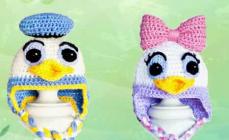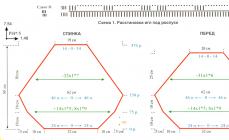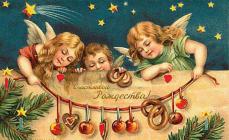Duck Marfutka
Patchwork is a patchwork sewing technique where a unique product is created from many pieces of fabric.
Bulky toys knitted from leftover yarn, like this cute Marfutka duck, belong to this type of needlework.
To complement the duck theme, knit beautiful hats for the kids.
For babies aged from three months to six months, who do not yet distinguish birds by appearance, you can knit duck-themed hats as an addition to the toy.
Duck Marfutka
Why Marfutka? She resembles a kind and elegant housewife. He moves slowly, waddling from one side to the other. She has a great character. Unlike geese, these breeds of birds never rush at people. The name says it all.
Knitting materials:
- yarn Coats & Clark Red Heart TLC, 170 g / 285 m;
- yarn colors - light purple, dark pink, bright green, yellow, light pink, black;
- hook No. 6;
- filler synthetic winterizer (holofiber, synthetic foam balls or others);
- tapestry needle.
Some notes
5 sc = 2.5 cm, and the height of the finished toy is 27 cm. At the beginning of knitting each row there is a lifting air loop, at the end of the row there is a connecting loop.
Knitting a toy begins with a bright green thread from the top of the head. Typically, oval pieces begin with knitting a “magic ring” (see table).
During knitting, add filler to the pieces. Embroider the eyes. An additional abbreviation has been introduced in the description of knitting, namely: “ Sat" - this is the loop of the previous row.
Description of knitting
Head and body of a duck
Start knitting with a bright green thread.
row 1: knit a “magic ring” of 6 sc
row 2: increase.
Row 3: (sc, increase) * 6.
Row 4: sc in each stitch of the round row.
Row 5: (2 sc, increase) * 6.
Row 6: (3 sc, increase) * 6.
rows 7-14: repeat row 4.
Row 15: (3 sc, decrease) * 6.
Row 16: (2 sc, decrease) * 6.
row 17: repeat row 4.
At the end of the row, attach a light pink thread.
rows 18-20: repeat row 4.
At the end of the 20th row, attach a light purple thread.
row 21: repeat row 4.
row 22: increase everywhere.
Place filler into the connected part.
row 23: repeat row 4.
Row 24: 16 sc, 2 hdc, 2 dc! sc, 2 dc! sc, 2 hdc! sc, 16 sc! 16 sc.
Row 25: 18 sc! 18 sc, 2 hdc! sc, 2 dc! sc, 2 dc! sc, 2 hdc! sbn, 18 sbn! 18 sc.
Row 26: 20 sc! 20 sc, 2 hdc! sc, 2 dc! sc, 2 dc! sc, 2 hdc! sc, 20 sc! 20 sc.
Row 27: 22 sc! 22 sc, 2 hdc! sc, 2 dc! sc, 2 dc! sc, 2 hdc! sbn, 22 sbn! 22 sc.
row 28-30: repeat row 4.
Rows 31: 24 sc! 24 sbn, decrease * 2, 24 sbn! 24 sc.
Row 32: 23 sc! 23 sbn, decrease * 2, 23 sbn! 23 sc.
Row 33: 22 sc! 22 sbn, decrease * 2, 22 sbn! 22 sc.
Row 34: 21 sc! 21 sbn, decrease * 2, 21 sbn! 21 sc.
Row 35: 20 sc! 20 sc, decrease * 2, 20 sc! 20 sc.
Row 36: (5 sc, decrease) * 6.
Row 37: (4 sc, decrease) * 6.
Place the filler into the piece and continue knitting
Row 38: (3 sc, decrease) * 6.
Row 39: (2 sc, decrease) * 6.
Row 40: (sc, decrease) * 6.
row 41: decrease everywhere. [X]
Embroider eyes with black thread between 8-9 rows at a distance of 4 cm between them.
Beak (2 pcs.)
Knit with yellow thread.
row 1: knit a “magic ring” of 8 sc.
Rows 2-4: sc in each stitch of the round row.
Row 5: (sc, increase) * 4. [X]
Sew the beak to the head, slightly below the eyes. [Q]
Wings (2 pcs.)
Knit with dark pink thread.
Row 2: increase, 5 sc.
Row 3: 2 sc, increase, 4 sc.
Row 4: 4 sc, increase, 3 sc.
Row 5: 6 sc, increase, 2 sc.
Row 6: 8 sc, increase, sc.
Row 7: 10 sc, increase.
Row 8: (sc, increase) * 6 times.
Row 9: sc in each stitch of the round row. [X]
Do not put filler in the wing!
Sew to the side of the body as shown in the photo. [Q]
Paws (2 pcs.)
Knit with yellow thread.
row 1: knit a “magic ring” of 6 sc.
row 2: increase everywhere.
Row 3: sc in each stitch of the round row.
row 4: repeat row 3.
Row 5: (sc, increase) * 6.
row 6: repeat row 3.
Row 7: (2 sc, increase) * 6.
row 8: repeat row 3. [X]
Insert the thread into the needle. Sew the eighth row through both thicknesses and form webbed feet in two places, tightening rows 6-7 with a stitch (pull the thread and sew tightly several times).
Sew the legs to the lower body.
Duck hats for babies
From the photograph it is immediately clear which of the hats is knitted for a boy and which for a girl. They differ in colors and decorations.

Hat for a small child
For a boy, knitting differs only in the color of the threads and the sailor's cap, which is described at the end of the text. The girl's hat is decorated with a luxurious bow.
Hat for girls aged from three to six months. The head circumference is 40 cm and the hat height is 16.5 cm.
Materials for knitting a baby hat:
- yarn 8 ply, 100% cotton, 55 g /165 m;
- white yarn 50 g and five colors 20 g each: black, bright yellow, light lilac, pink;
- hook No. 5 and No. 6;
- scissors;
- tapestry needle.
Top of the cap
Crochet number 6 with white yarn. Count the first two chain stitches of the row as a half double crochet.
1st row: knit a chain of 2 ch, knit 7 hdc, sp-2 into the second loop from the hook.
2nd row: 2 ch + hdc, knit 2 hdc in each loop, sp-2.
Row 3: ch 2 + hdc, (hdc, 2 hdc in next stitch) * in each stitch, sp-2.
Row 4: ch 2 + hdc, (2 hdc, 2 hdc in next stitch) * in each stitch, sp-2.
Row 5: ch 2 + hdc, (3 hdc, 2 hdc in next stitch) * in each stitch, sp-2.
Row 6: ch 2 + hdc, (2 hdc, 2 hdc in next stitch) * in each stitch, sp-2.
Rows 7-12: hdc in each stitch, sp-2.
Change the thread color to pink.
Rows 13-14: hdc in each stitch, sp-2.
Rows 15-16: ch 2, 35 hdc, turn.
Left ear
1st row: ch, decrease, 6 hdc, decrease, turn.
2nd row: ch, decrease, 4 hdc, decrease, turn.
3rd row: ch, decrease, 2 hdc, decrease, turn.
4th row: ch, decrease. [Q]
Right ear
Attach a light lilac thread to the last loop of the 16th row, opposite the knitted left eyelet.
Knit according to the description of the right ear.
Edging of a hat with ears
Attach the light lilac thread to the back of the hat.
Using crochet hook No. 6, tie around with single crochets (psbn). [Q]
Iris (2 pcs.)
Using crochet number 5 with blue thread, knit a chain of 4 ch and connect into a ring.
1st row: ch, 3 sc, 3 sc in last loop, turn knitting; sc to the last loop, knit 2 sc into the last loop, sp-1.
2nd row: ch, (2 sc, knit 2 sc in each of the next three loops) * 2 times, sp-2.
Row 3: ch, (2 sc, knit 2 sc in each of the next six stitches) * 2 times, sp-2. [X]
Eye pupils (2 pcs.)
Using crochet hook No. 5 and black thread, knit a chain of 2 chs. In the second loop from the hook, tie 9 hdc, sp-2. [X]
Using white thread, embroider a highlight in the upper left corner of the eye.
Sew the pupils onto the shell of the eyes, and then onto the front of the cap, using the photo as a guide.
Eyelashes (2 pcs.)
Using crochet hook No. 5 with black thread, knit a chain of 11 ch, knit a psc into each loop of the chain.
Sew the black detail above the eyes with a needle, embroidering 2-3 eyelashes with stitches, as shown in the photo. [Q]
duck beak
Using crochet number 6 and bright yellow thread, knit rows 1-4 according to the description “Top part of the cap.”
Fold the circle piece in half and use a tapestry needle to sew the outer corners.
Then sew the Duck Beak to the front of the hat, right under the eyes. [Q]
Bow as a decoration for a girl's hat
Using crochet number 5 with pink thread, knit a chain of 40 ch and connect into a ring.
1st row: ch 2, prop. 2, hdc to end of row, sp-2.
Rows 2-8: ch 2, hdc in each stitch, sp-2.
Fold the piece into a double rectangle, stitch it in the center with a needle and wrap pink thread around it at least 15 times.
Sew a bow in the middle of the top of the hat. [Q]
Braided tassel ties (2 pcs.)
From multi-colored yarn, cut 12 threads (4 of each color) 75 cm in length. Then do the following:
- Tie a simple knot at the bottom of the left ear and braid it.
- Tie a knot at the end and cut off any excess yarn.
- Repeat the previous steps for the right ear of the cap.
Sailor cap as decoration
Crochet No. 6 with blue yarn for the first five rows according to the description “Top part of the cap.”
Rows 6-7: hdc in each loop around, sp-2.
Change the thread color to black.
Row 8: ch 2, 2 hdc, (decrease, 3 hdc) * around, sp-2.
Row 9: ch 2, hdc in each stitch, sp-2. [X]
Sew the knitted piece in the middle of the top of the hat. [Q]
Addition
When starting to knit, carefully consider the information about the abbreviated names of the stitches so that the result is not disappointing.
Abbreviated names of loops
| Abbreviated names of loops | Names of loops |
|---|---|
| slp, next p, next a loop | next loop |
| decrease | pull the working thread through the first loop, then through the second and knit them together |
| decreaseSS | knit two unfinished double crochets together by pulling the working yarn through 3 loops on the hook. |
| decreasePSSN | through two hdcs not knitted to the end (5 loops on the hook), pull the working thread |
| VP | air loop |
| sc | single crochet |
| dc | double crochet |
| ss2n | double crochet stitch |
| ss3n | double crochet stitch |
| psbn | half crochet |
| pssn | half double crochet |
| increase | 2 sc in one loop |
| increaseSS | 2 dc in one loop |
| increasePSSN | 2 hdc in one loop |
| sp-N | connecting loop, pull the thread through the Nth loop of the beginning of the row and the last knitting loop |
| connection loop | connecting loop; pull the working yarn through the first loop of the row and the loop on the hook |
| prop.N | skip N stitches |
| (ch + sc) | The plus sign indicates that both loops are knitted into one loop. |
| arch | chain of several chs in a knitting pattern |
| ! | (exclamation mark) - to the left of the sign is what we are knitting, and to the right - where we are knitting in the previous one. a number of |
| * | repeat the specified number of times |
| twist or turn | turn knitting |
| previous row | previous row |
| ( ),() or (()) | brackets enclose a group of loops that are performed a specified number of times |
| number of loops in knitted row | |
| [X] | Fasten the thread, but do not cut it. Leave the tip 15-20 cm. |
| [Q] | Fasten the thread, hide the end of the thread inside the part and cut it. |
| "around" | the word “around” means that the indicated stitch must be knitted into each stitch of the circular row |
| "everywhere" | the word “everywhere” means that in each loop of a circular or flat row, knit the indicated stitch |
| RN | working thread |

Children, especially preschoolers, love to play with small toys. They can be carried in a backpack, placed in houses, placed under a pillow or pocket. You can knit such a small toy yourself. Cute bird community for the poultry yard - crocheted chicken and duckling.

The chick and duck crochet methods are similar, there are only slight differences, so the descriptions of the models are similar.

For knitting, fairly thick yellow and red acrylic yarn and an N4 hook are used to ensure the tightest knitting. The main knitting technique is double crochet.
Chick.




Knitting with yellow yarn begins by making a circle: 3 ch, close into a ring, then 6 double crochets into the ring, then into each loop of the bottom row we knit 2 double crochets. In rows 3, 4, 5, add 1 double crochet to every second stitch of the bottom row. Then we stop adding loops and knit rows 6, 7, 8, 9, getting a cylindrical shape.
Then we decrease the loops through one in the 10th, 11th row, getting a chicken neck. Then we repeat the addition of loops in every second loop of the bottom row in the 12th, 13th and 14th rows. We fill the figure with light and voluminous filler, for example, padding polyester. Then we close the loops by knitting two loops of the bottom row together. We supplement the toy with another portion of filler. Close the last 4 loops with one loop, forming the crown.




For the tail, we cast on 4 loops at the bottom of the form, which we knit with double crochets in 3 rows. Then we connect the last loop of the 3rd row with the first, forming a corner.
Duckling.

We start knitting not with a circle, but with an oval. To do this, dial 5 vp. and knit in the round as described for the chicken model. In the 10th row, we begin to decrease the loops: we knit half the row, then turn the knitting, perform the opposite direction of the double crochet, decreasing one loop in the center. Turn the knitting again, knit the same half of the row, decreasing 2 loops in the center. Next, we continue knitting 2 rows of double crochet stitches in the round, forming the neck of the duck. Then evenly add 4 loops in the 13th row, 4 loops in the 14th row. Then we decrease the loops, just as described in the previous model. We perform the tail in the same way, but make it a little larger - 5 loops.
Wings. The wings are knitted with separate stitches: with yellow yarn we make a chain of 5 chain stitches. and we knit them in a circle in 3 rows, loops are added when turning the knitting 3 vp into the outermost loop of the row. You should get 4 wings.



Beaks. Change the yarn to red and knit the beaks. To do this, cast on 4 chain stitches for a chicken or 5 chain stitches for a duckling directly on the toy shape. For the chicken from the second row, we reduce the loops, getting a thinner beak. For the duckling we knit 3 rows without decreasing the loops, in the 4th row we decrease 2 loops and close the row.

For the chicken, also tie a small comb. We collect 7 chain stitches with red yarn on the top of the toy model. We knit the reverse row according to the pattern: *2 double crochets in each loop, 3 double crochets in one loop of the bottom row*.
You will need:
Yarn in 2 colors - bright yellow and orange;
- filler - synthetic winterizer, if available, or cotton wool;
- hook;
- blanks for eyes or beads;
- thread and needle.
First, we knit the body of the duckling using bright yellow yarn according to pattern 1.
Then, using pattern 2, we knit the head with the same yarn. 
Diagram 3 shows how to knit a wing (we knit them with 2 identical bright yellow yarns). If desired, it can not be knitted, as shown in the example of the finished product.
We also knit the beak this time with orange yarn according to pattern 4 or pattern 4.1 (in the first it will be more curved). You can use 2 types of beaks to knit different ducklings.
A more detailed master class on how to do this is presented below (lesson 1 to 20). 
After all the necessary parts are ready, we stuff them and begin assembling our duckling. We sew the beak to the head and attach eyes to the sides of it (if these are beads, we sew them on). We sew wings to the body on both sides. Then we attach the head to the body. Our bright duckling is ready. 
Amigurumi ducklings
1 - air loop;
2 - single crochet;
3 - 2 single crochets in one loop of the previous row;
We knit 4 - 2 single crochets as 1;
We knit 5 - 3 single crochets as 1;
6 - air loop for lifting to the next row;
7 - single crochet, which we knit only behind the back wall of the previous row






